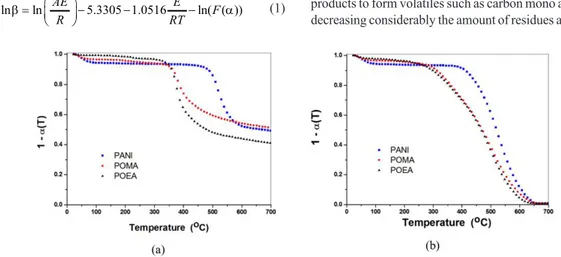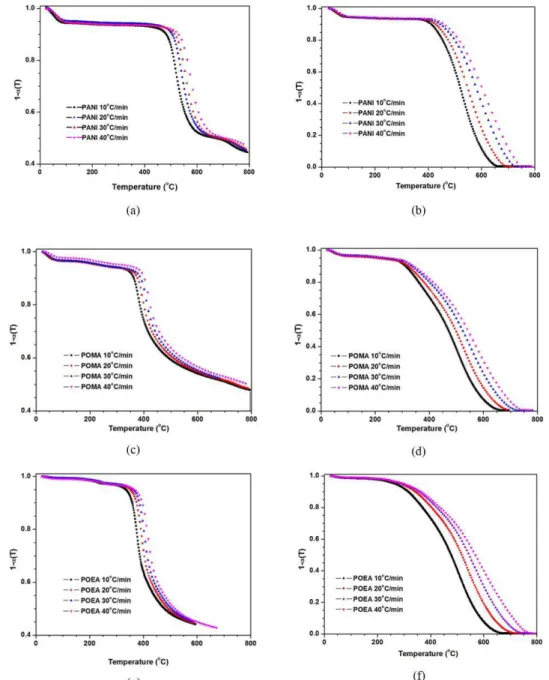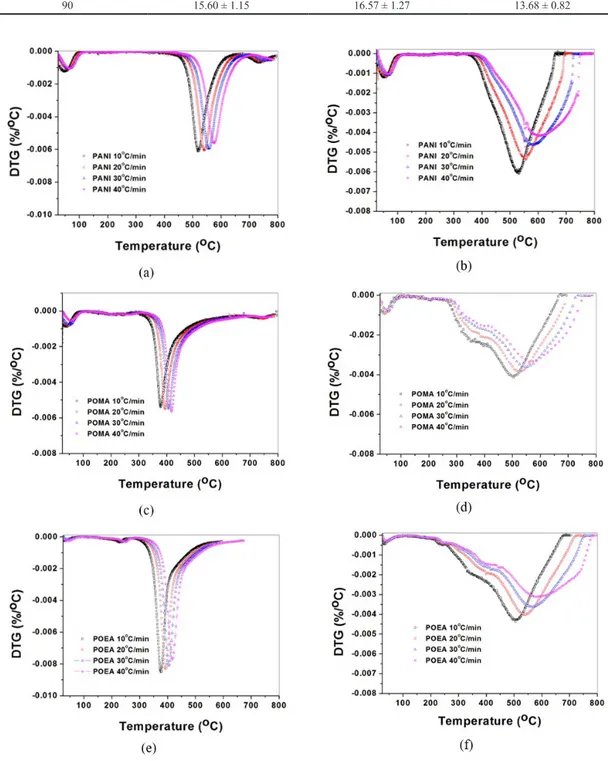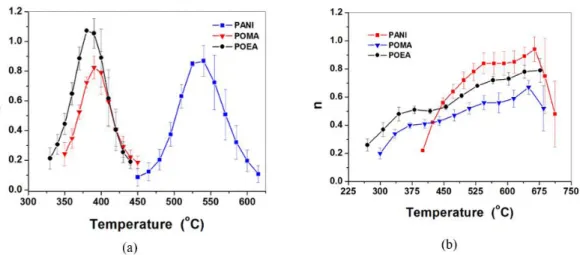O
R
I
G
I
N
A
L
A
R
T
I
C
L
E
Non-isothermal decomposition kinetics of conductive
polyaniline and its derivatives
William Ferreira Alves
1, José Antonio Malmonge
2, Luiz Henrique Capparelli Mattoso
3and Eliton Souto de Medeiros
4*1
Universidade Federal do Acre – UFAC, Campus Floresta, Cruzeiro do Sul, AC, Brasil
2
Departamento de Física e Química – DFQ, Universidade Estadual Paulista “Júlio de Mesquita Filho” –
UNESP, Campus de Ilha Solteira, Ilha Solteira, SP, Brasil
3
Laboratório de Nanotecnologia para o Agronegócio – LNNA, Centro Nacional de Pesquisa e
Desenvolvimento de Instrumentação Agropecuária – CNPDIA, Empresa Brasileira de Pesquisa
Agropecuária – EMBRAPA, São Carlos, SP, Brasil
4
Laboratório de Materiais e Biossistemas – LAMAB, Universidade Federal da Paraíba – UFPB,
João Pessoa, PB, Brasil
*eliton@ct.ufpb.br
Abstract
The non-isothermal decomposition kinetics of conductive polyaniline (PANI) and its derivatives, poly(o-methoxyaniline) (POMA) and poly(o-ethoxyaniline) (POEA), was investigated by thermogravimetric analysis (TGA), under inert and oxidative atmospheres, using Flynn-Wall-Ozawa’s approach to assess the kinetic parameters of the decomposition process. The order of reaction was found to be dependent on the degree of conversion indicating that both the early and the later stages of polymer degradation were next the zero or pseudo zero order kinetics, whereas the intermediate stages follow a first order kinetics. The activation energy was found to be dependent on both the degree of conversion and PANI derivative. Activation energy values vary from 125 to 250 kJ/mol, to decompositions carried out under nitrogen, and 75 to 120 kJ/mol to oxidative atmosphere. Parent PANI presented the best thermal stability and suggesting that thermal stability is also influenced by derivatization and type of atmosphere used.
Keywords: PANI, POEA, POMA, thermal decomposition, Flynn-Wall-Ozawa’s approach.
1. Introduction
Polyaniline (PANI) and its derivatives poly(o-methoxyaniline) (POMA) and poly(o-methoxyaniline) (POEA) have been intensively studied due to their electrical and optical properties, low cost, good processability and a broad range of applications ranging from sensors and biosensor to smart windows and nanodevices[1,2]. More recently, the development of PANI nanostructures has opened up a new range of potential applications, due to their high surface area, controllable electrical conductivity, and ease of preparation[3]. Several authors are extensively studied the use of PANI nanofibers in the manufacture of electronic devices such as gas sensors, super capacitors and biomedical applications[4-6].
Regarding PANI thermal behavior, it is known that the conducting state presents a three-step decomposition process, where the first step is attributed to water evaporation, the second to loss of the dopant and the third to breaking of carbon backbone in the polymer, while the insulating state of PANI (emeraldine base) displays two peaks: one at low temperature attributed to water loss and the second at higher temperatures, attributed to polymer decomposition[7-11]. Additionally, PANI powders and films have been studied by Differential scanning calorimetry (DSC) and dynamic mechanical thermal analysis (DMTA) to evaluate its thermal
properties. However, there are few studies related to the thermal behavior of PANI derivatives in emeraldine base form.
Thermal analysis of conducting polymers is of great interest to determine their thermal behavior in various technological applications, since it provides important information on the effect of morphological and structural changes such as cross-linking and functionalization. This method has been largely used in the study of curing and degradation of polymers and decomposition of several other substances[12-17]. Improvements in the determination of the kinetic triplet – activation energy, pre-exponential factor and order of rection – has been proposed by several other authors, including more accurate solutions for the the temperature integral. A critical evaluation of the isoconventional methods has been reviewed in the literature[17].
2. Materials and Methods
2.1 Materials
Polyaniline (PANI), poly(o-methoxyaniline) (POMA) and poly(o-ethoxyaniline) (POEA) were chemically synthesized according to the method described in the literature[10,11]. Briefly, the monomers of conducting polymers were dissolved in an acidic solution (HCl 1,0 M) separately and cooled to low temperature (0-2 °C). After cooling period, the solution containing the oxidant ((NH4)2S2O8) was poured in the acidic solution with the monomers. After 2 hours of reaction time, for the formation of the polyaniline, and 4 hours, for the formation of the derivatives, all polymers in the doped state (emeraldine salt, ES) were filtered, rinsed with distilled water and dried. Dedoping was performed by treatment with a 0.1 M ammonium hydroxide aqueous solution for 16 hours at a room temperature (~25 °C) to convert these polymers to the emeraldine base form (EB). Then they were filtered and transferred to a desiccator to dry under vacuum for 24 hours at a room temperature (~25oC) prior to thermal analyses.
2.2 Flinn-Wall-Ozawa’s approach
A model Q 600 TA Instruments TGA was used to investigate the kinetics of thermal decomposition of the polymers, which was carried out in a platinum crucible. About 10 mg of the conducting polymers were run using dynamic scans from 25 to 900 °C, at constant heating rates of 10, 20, 30 and 40oC/min under nitrogen and synthetic air atmospheres, at a flow rate of 50 mL/min.
In order to obtain the kinetic parameters of polymer degradation, thermogravimetric curves were analyzed according to Flynn–Wall–Ozawa’s approach using the methodology described in our previous works on rubber decomposition[12]. Briefly, when a polymeric material undergoes thermal decomposition according to the reaction
(s) (s) (g)
aA →bB +cC , if the decomposition starts at a temperature (T0) and is carried out at a linear increasing in temperature (T=T0+βt), where β is the constant heating rate ( dT
dt
β = ), the thermal decomposition events can be described by the following expression[13-16]:
ln ln AE 5.3305 1.0516 E ln( ( ))F
R RT
β = − − − α
(1)
where, α is the fraction of the polymer that undergoes decomposition or the conversion degree, A is the pre-exponential factor, E is the activation energy of the degradation process, R is the gas constant and F(α) is a power series expansion. Therefore, for a constant degree of conversion (α=constant), a plot of ln(β) versus 1/T, obtained from TGA curves, recorded at several constant heating rates (β), should result in a straight line whose slope is approximately –1.0516E/R. The reaction order can be determined by an extension of Avrami’s theory to describe non-isothermal as:
ln{ ln[1 ( )]}T ln( )A E nln( )
RT
− − α = − − β (2)
Hence, a plot of ln[-ln(1-α( ))]T versus ln(β), which is
obtained at the same temperature from a number of isotherms taken at different heating rates, should yield straight lines whose slope is reaction order or the Flynn-Wall-Ozawa’s exponent (n)[18-20]:
3. Results and Discussions
Thermogravimetric curves of PANI, POMA and POEA at the heating rate of 10oC/min under nitrogen (a) and oxidative atmosphere (c) are shown in Figure 1. It can be observed in Figure 1a, as expected, that the onset of the thermal decomposition of PANI under nitrogen atmosphere occurs at 473°C and about 49.2% of residue is formed at 700°C; for POMA and POEA, the thermal decomposition starts, respectively, at 362 and 337°C, with 51.0 and 41.7% residue at 700°C. Figure 1b shows that PANI decomposition under oxidative atmosphere starts at 411°C with practically no residue after 650 °C; POMA and POEA had, respectively, onsets of decomposition at 283 and 289°C and, similarly to PANI, no residue after 650oC. The decomposition path of the samples under nitrogen and the oxidative atmosphere are different. While, under nitrogen atmosphere, degradation shows an ordinary path with 41.7% residue due to the protective atmosphere that causes a controlled degradation, the oxidative atmosphere, after the onset of degradation, had an almost sharp decrease in weight beause the presence of oxygen molecules combine with some of the degradation products to form volatiles such as carbon mono and dioxide decreasing considerably the amount of residues after 650°C.
Comparing the onset temperatures under nitrogen and oxygen, PANI presents highest onset temperature, indicating therefore the highest thermal stability among its derivatives. This might have taken place probably due to the high density of hydrogen bond between chains, which is a drawback in PANI dissolution, and because PANI has no alkyl group (eg methoxy and ethoxy) which facilitates the cross-linking reaction in pristine PANI, while in its derivatives these alkyl groups prevent cross-linking (due to steric hindrance) from taking place during heating[19]. Therefore, as the temperature increases, cross-links between PANI takes place between chains to form a more thermally stable structures[20,21].
The kinetics of thermal decomposition of conducting polymers was studied by thermogravimetry at different heating rates, and the kinetic parameters were calculated using the method Flynn-Wall-Ozawa[22-26]. The weight loss as a function of the temperature for the heating rates of 10, 20, 30 and 40°C/min is shown in Figure 2.
Figure 2 shows that for both the atmospheres (inert and oxidative) an increase in heating rate caused the decay curves to shift to higher temperatures, and profiles of the curves of thermal decomposition of conducting polymers have the same behavior, which is a consequence of the events having
less time to take place as well as poorer heat diffusion into the samples, a well-known fact in TGA analysis of polymers.
From Equation 1, it was possible to calculate the activation energy over the entire range of decomposition of conducting polymers under both nitrogen and synthetic air atmospheres. Taking the ln [-ln (1-a (T))] vs ln (b), the slope, the activation energy Ea was calculated and the y-axis intercept used to determines the pre-exponential factor A as described earlier and shown in Figure 3.
Figure 3a, b shows a plot of the activation energy as a function of weight loss PANI, POMA and POEA in nitrogen and oxygen atmospheres. In general, PANI displayed a somewhat higher energy of activation for degradation in both atmospheres as compared to POMA and POEA. These results are in agreement with the results of the onset of thermal decomposition of PANI as already discussed. Moreover, comparing the effect of the atmospheres on Ea values, one can observe that the activation energy values under nitrogen are slightly higher than under oxidative atmosphere. This happened because the presence of oxygen is known to catalyze the thermal decomposition of polymers. Moreover, along the degradation pathway, in the active pyrolysis region of the curve, the activation energy under oxygen remained almost constant while for nitrogen it started to increase after 40% conversion. This might have happened because of the formation of cross-linked structures, at higher extent to PANI and lower to POMA and POEA, which resulted in a more thermally stable structure.
Wang et al.[21], synthesized and characterized the thermal property of polyanilina with ZrO2, forming the composite NIBP/ZrO2, comparing the Ea, using Ozawa-Flynn-Wall. The authors found that the Ea of PANI, in air atmosphere was below 100 kJ.mol-1, while the PANI/ZrO
2 presented Ea values above 100 kJ.mol-1. These results are also in the same range of values found by Corradini et al.[26] who compared the thermal stability of various types of cotton using Ozawa’s model, in determining the activation energy for white cotton fibers.
Tables 1 and 2 show the pre-exponential values of thermal decomposition for PANI, POEA and POMA, respectively, under inert and oxidative atmosphere.
It can be also observed in Table 1 that the values of the pre-exponential factors for PANI, POMA and POEA as a function of the extent of thermal decomposition from 10 to 90% did not show any significant differences when comparing between the polymers. However, comparing nitrogen or oxygen atmospheres, ln(A) values were significantly lower to oxygen than to nitrogen. For the values of pre-exponential factors under oxidative atmosphere, there is a decrease in ln(A) with increasing mass loss, especially in the range between 10 and 50%. These differences can be explained by the fact that under nitrogen atmosphere the active pyrolysis region occurs oven a narrower range of temperature than under oxygen as can be seen in DTG curves (Figure 4).
This behavior (Figure 4) is due to the fact that under protective (inert) atmosphere the degradation steps are fewer
Figure 3. Curve vs. Ea. α (T) of conducting PANI (Polyaniline) and its derivatives POEA (Poly(o-ethoxyaniline)) and POMA (Poly(o-methoxyaniline)) in the atmosphere (a) nitrogen and (b) oxygen.
Table 1. Table of values pre-exponential factor of conducting polymers under nitrogen atmosphere.
ln (A)
α (%) PANI (Polyaniline) POMA (Poly(o-methoxyaniline)) POEA (Poly(o-ethoxyaniline))
10 26.82 ± 1.98 26.31 ±2.52 27.00 ± 1.60
15 25.47 ± 2.09 26.87 ± 1.95 26.63 ±1.63
20 24.96 ± 2.30 27.47 ± 2.17 26.87 ± 1.66
25 24.87 ± 2.36 27.91 ± 2.22 27.05 ± 1.93
30 25.30 ±2.37 27.40 ± 2.27 27.24 ± 1.82
35 25.32 ± 2.80 26.15 ± 3.30 27.12 ± 2.09
40 25.97 ±2.74 24.48 ± 3.15 30.72 ± 2.10
45 26.50 ± 3.10 23.37 ± 4.77 30.70 ± 2.09
Table 2. Pre-exponential factor of the conducting polymers under synthetic air atmosphere.
ln (A)
α (%) PANI (Polyaniline) POMA (Poly(o-methoxyaniline)) POEA (Poly(o-ethoxyaniline))
10 23.25 ± 2.25 22.90 ±1.57 20.12 ± 0.98
20 19.67 ± 1.79 20.37 ± 1.57 16.92 ±0.38
30 18.66 ± 1.80 17.77 ± 1.36 15.71 ± 0.17
40 18.11 ± 1.48 17.72 ± 1.27 15.57 ± 0.10
50 12.22 ± 1.52 18.03 ± 1.25 15.31 ± 0.26
60 16.30 ± 1.35 17.58 ± 1.36 14.64 ± 0.61
70 15.57 ± 1.31 16.98 ± 1.42 14.12 ± 0.70
80 15.34 ± 1.24 16.38 ± 1.38 13.92 ± 0.98
90 15.60 ± 1.15 16.57 ± 1.27 13.68 ± 0.82
and more uniform, without many side reactions. On the other hand, the presence of oxygen, as already pointed out, catalyzes the oxidative degradation giving rise to a multi-step degradation (Figure 5), with several reactions occurring simultaneously, and thus producing a series of intermediary compounds that degrade over a broader range of temperature. As the temperature increases, the random break the bonds along polymer backbone gives rise to the formation of free radicals that attack other polymer chains, forming radicals and, ultimately, intermediary compounds.
The order of decomposition reaction, n, of conducting polymers was obtained from the slope of ln[-ln (1- α (T))] vs ln (β), as shown in Figure 6.
It is observed in Figure 6 that the order of reaction (n) varied with the temperature for both atmospheres. A noteworthy observation is the overall shape of the n versus temperature curve. It has a bell-shaped form to all polymers under nitrogen as a consequence of a more uniform and controlled decomposition similarly to other polymers such as rubbers[27,28]. However,
shape of the n versus temperature curve of the decomposition of PANI, POEA and POMA under oxygen is very different due to the multi-step degradation abovementioned.
The decomposition the kinetic models described by Coats and Redfern[29], Broido[30] and Horowitz and Metzger[31], the determination of kinetic parameters, are accomplished by considering the reaction order to be equal to 1 throughout decomposition range. According to the results obtained here, it was observed that reaction order varies between 0 and 1.1 instead of being constant. These values indicate that a complex decomposition process is taking place. While it is more predictable and uniform to reactions under nitrogen atmosphere, the presence of oxygen in the oxidative decomposition makes the reaction mechanisms more complex with oxygen intermediating and catalyzing side reactions as the temperature increases.
4. Conclusions
The kinetics of decomposition of PANI, POEA and POMA was carried out using the Flynn-Wall-Ozawa method access the decomposition triplet (energy of activation, pre-exponential factor and reaction order) under oxidative and inert atmospheres. It was observed that PANI showed a higher activation energies than POMA and POEA. The lower values Ea for POMA and POEA could be due to alkyl groups that decrease cross-linking formation thus decreasing the thermal stability of these polymers. There were no significant differences in pre-exponential parameters of conducting polymers when comparing among these polymers. However, the order of degradation reaction, which varied from ca. 0 to 1.1 was very dependent on the atmosphere. This behavior was thus attributed to the presence of oxygen that makes the oxidative degradation more complex than under nitrogen. In general, there was a trend for PANI to be the most thermally stable polymer among them.
Figure 5. Scheme of general degradation of polymers by oxidation[27].
5. Acknowledgements
The authors acknowledge the financial support given by Conselho Nacional de Desenvolvimento Científico e Tecnológico (CNPq) and Fundação de Amparo à Pesquisa do Estado do Acre (FAPAC).
6. References
1. Bhadra, S., Khastgir, D., Singha, N. K., & Lee, J. H. (2009). Progress in preparation, processing and applications of polyaniline.
Progress in Polymer Science, 34(8), 783-810. http://dx.doi. org/10.1016/j.progpolymsci.2009.04.003.
2. Saranya, K., Rameez, M., & Subramania, A. (2015). Developments in conducting polymer based counter electrodes for dye-sensitized solar cells – An overview. European Polymer Journal, 66, 207-227. http://dx.doi.org/10.1016/j.eurpolymj.2015.01.049.
3. Ćirić-Marjanović, G. (2013). Recent advances in polyaniline
research: Polymerization mechanisms, structural aspects, properties and applications. Synthetic Metals, 177, 1-47. http:// dx.doi.org/10.1016/j.synthmet.2013.06.004.
4. Picciani, P. H. S., Medeiros, E. S., Orts, W. J., & Mattoso, L. H. C. (2011). Advances in electroactive electrospun nanofibers.
In Tong Lin (Ed.), Nanofibers - production, properties and functional applications (p. 85-116). Rijeka: InTech. http:// dx.doi.org/10.5772/23229.
5. Prathap, M. U. A., Satpati, B., & Srivastava, R. (2013). Facile preparation of polyaniline/MnO2 nanofibers and its electrochemical application in the simultaneous determination of catechol, hydroquinone, and resorcinol. Sensors and Actuators B: Chemical,
186, 67-77. http://dx.doi.org/0.1016/j.snb.2013.05.076. 6. Razak, S. I. A., Wahab, I. F., Fadil, F., Dahli, F. N., Md Khudzari,
A. Z., & Adeli, H. (2015). A review of electrospun conductive polyaniline based nanofiber composites and blends: processing features, applications, and future directions. Advances in Materials Science and Engineering, 2015, 1-19. http://dx.doi. org/10.1155/2015/356286.
7. Matveeva, E. S., Diaz Calleja, R., & Parkhutik, V. P. (1995). Thermogravimetric and calorimetric studies of water absorbed in polyaniline. Synthetic Metals, 72(2), 105-110. http://dx.doi. org/10.1016/0379-6779(94)02335-V.
8. Tsocheva, D., Zlatkov, T., & Terlemezyan, L. (1998). Thermoanalytical studies of polyaniline ‘Emeraldine base’.
Journal of Thermal Analysis and Calorimetry, 53(3), 895-904. http://dx.doi.org/10.1023/A:1010146619792.
9. Chen, C. H. (2002). Thermal studies of polyaniline doped with dodecyl benzene sulfonic acid directly prepared via aqueous dispersions. Journal of Polymer Research, 9(3), 195-200. http:// dx.doi.org/10.1023/A:1021395726060.
10. Mattoso, L. H. C., Manohar, S. K., Macdiarmid, A. G., & Epstein, A. J. (1995). Studies on the chemical syntheses and on the characteristics of polyaniline derivatives. Journal of Polymer Science. Part A, Polymer Chemistry, 33(8), 1227-1234. http:// dx.doi.org/10.1002/pola.1995.080330805.
11. Malmonge, L. F., & Mattoso, L. H. C. (1995). Electroactive blends of poly(vinylidene fluoride) and polyaniline derivatives.
Polymer, 36(2), 245-249. http://dx.doi.org/10.1016/0032-3861(95)91310-4.
12. Medeiros, E. S., Galiani, P. G., Moreno, R. M. B., Mattoso, L. H. C., & Malmonge, J. A. (2010). A comparative study of the non-isothermal degradation of natural rubber from Mangabeira (Hancornia speciosa Gomes) and Seringueira (Hevea brasiliensis).
Journal of Thermal Analysis and Calorimetry, 100(3), 1045-1050. http://dx.doi.org/10.1007/s10973-009-0477-6.
13. Ozawa, T. (1965). A new method of analyzing thermogravimetric data. Bulletin of the Chemical Society of Japan, 38(11), 1881-1886. http://dx.doi.org/10.1246/bcsj.38.1881.
14. Ozawa, T. (1975). Critical investigation of methods analysis of thermoanalytical data. Journal of Thermal Analysis, 7(3), 601-617. http://dx.doi.org/10.1007/BF01912021.
15. Flynn, J. H. (1978). Thermogravimetric analysis and differential thermal analysis. In H. H. G. Jellinek (Eds.), Aspects of degradation and stabilization of polymers (p. 573-615). New York: Elsevier.
16. Saltan, F., & Akat, H. (2013). Synthesis and thermal degradation kinetics of D–(+)–galactose containing polymers. Polímeros: Ciência e Tecnologia, 23(6), 697-704. http://dx.doi.org/10.4322/ polimeros.2014.012.
17. Vyazovkin, S. (2015). Isoconversional kinetics of thermally stimulated processes. Berlin: Springer. http://dx.doi.org/10.1007/978-3-319-14175-6.
18. Alves, W. F., Venancio, E. C., Leite, F. L., Kanda, D. H. F., Malmonge, L. F., Malmonge, J. A., & Mattoso, L. H. C. (2010). Thermo-analyses of polyaniline and its derivatives.
Thermochimica Acta, 502(1–2), 43-46. http://dx.doi.org/10.1016/j. tca.2010.02.003.
19. Chan, H. S. O., Gan, L. M., Hor, T. S. A., Seow, S. H., & Zhang, L. H. (1993). Thermal-analysis of conducting polymers. Part 3. Isothermal thermogravimetry of doped and pristine polyaniline. Thermochimica Acta, 225(1), 75-83. http://dx.doi. org/10.1016/0040-6031(93)85084-M.
20. Souza, N. C., Silva, N. C., Giacometti, J. A., & Oliveira, O. N., Jr. (2006). H-bonding in entrapped water in poly(o-methoxyaniline): Results from a differential scanning calorimetry study. Thermochimica Acta, 441(2), 124-126. http://dx.doi. org/10.1016/j.tca.2005.12.016.
21. Wang, S.-X., Tan, Z.-C., Li, Y.-S., Sun, L.-X., & Li, Y. (2008). A kinetic analysis of thermal decomposition of polyaniline/ ZrO2 Composite. Journal of Thermal Analysis and Calorimetry,
92(2), 483-487. http://dx.doi.org/10.1007/s10973-007-8356-5. 22. Doca, N., Vlase, G., Vlase, T., Perta, M., Ilia, G., & Plesu,
N. (2009). TG, EGA and kinetic study by non-isothermal decomposition of a polyaniline with different dispersion degree.
Journal of Thermal Analysis and Calorimetry, 97(2), 479-484. http://dx.doi.org/10.1007/s10973-009-0217-y.
23. Zabihi, O., & Khodabandeh, A. (2013). Understanding of thermal/thermo-oxidative degradation kinetics of polythiophene nanoparticles. Journal of Thermal Analysis and Calorimetry,
112(3), 1507-1513. http://dx.doi.org/10.1007/s10973-012-2675-x. 24. Upadhyay, J., & Kumar, A. (2014). Investigation of structural,
thermal and dielectric properties of polypyrrole nanotubes tailoring with silver nanoparticles. Composites Science and Technology,
97, 55-62. http://dx.doi.org/10.1016/j.compscitech.2014.04.003. 25. Zhang, S., Wang, S., Huang, Z., Li, Y., & Tan, Z. (2015). A
kinetic analysis of thermal decomposition of polyaniline and its composites with rare earth oxides. Journal of Thermal Analysis and Calorimetry, 119(3), 1853-1860. http://dx.doi.org/10.1007/ s10973-014-4309-y.
26. Corradini, E., Teixeira, E. M., Paladin, P. D., Agnelli, J. A., Silva, O. R. R. F., & Mattoso, L. H. C. (2009). Thermal stability and degradation kinetic study of white and colored cotton fibers by thermogravimetric analysis. Journal of Thermal Analysis and Calorimetry, 97(2), 483-487. http://dx.doi.org/10.1007/ s10973-008-9693-8.
27. Pielichowski, K. (1997). Kinetic analysis of the thermal decomposition of polyaniline. Solid State Ionics, 104(1-2), 123-132. http://dx.doi.org/10.1016/S0167-2738(97)00396-2. 28. Medeiros, E. S., Moreno, R. M. B., Ferreira, F. C., Alves,
four different hevea rubber clones using Ozawa’s Approach.
Progress in Rubber, Plastics and Recycling Technology, 19(3), 189-204. http://dx.doi.org/10.1179/174328906X79932.
29. Coats, A. W., & Redfern, J. P. (1964). Kinetic parameters from thermogravimetric data. Nature, 201(4914), 68-69. http://dx.doi. org/10.1038/201068a0.
30. Broido, A. (1969). A simple, sensitive graphical method of treating thermogravimetric analysis data. Journal of Polymer
Science. Part A-2, Polymer Physics, 7(10), 1761-1773. http:// dx.doi.org/10.1002/pol.1969.160071012.
31. Horowitz, H. H., & Metzger, G. (1963). A new analysis of thermogravimetric traces. Analytical Chemistry, 35(10), 1464-1468. http://dx.doi.org/10.1021/ac60203a013.




